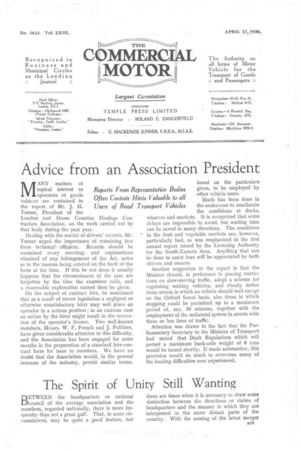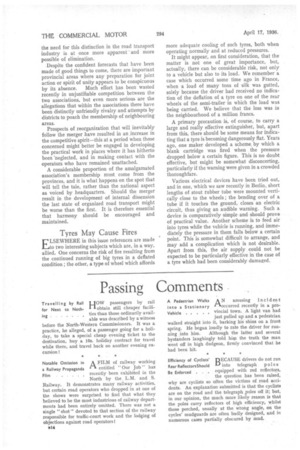The Spirit of Unity Still Wanting • B ETWEEN the headquarters or
Page 27

Page 28

If you've noticed an error in this article please click here to report it so we can fix it.
national 1-/council of the average association and the metxtbers, regarded nationally, there is more frequently than not a great gulf. That, in some circumstances, may be quite a good feature, but there are times when it is necessary to draw some distinction between the directions or claims of headquarters and the manner in which they are interpreted in the more distant parts of the country. With the coming of the latest merger the need for this distinction in the road transport industry is at once more apparent and more possible of elimination.
Despite the confident forecasts that have been made of good things to come, there are important provincial areas where any preparation for joint action or spirit of unity appears to be conspicuous by its absence. Much effort has been wasted recently in unjustifiable competition between the two associations, but even more serious are the allegations that within the associations there have been distinctly unfriendly rivalry and attempts by districts to poach the membership of neighbouring areas.
Prospects of reorganization that will inevitably follow the merger have resulted in an increase in the competitive spirit—this at a period when those concerned might better be engaged in developing the practical work in places where it has hitherto been 'neglected, and in making contact with the operators who have remained unattached.
A considerable proportion of the amalgamated association's membership must come from the provinces, and it is what happens on the spot that will tell the tale, rather than the national aspect as voiced by headquarters. Should the merger result in the development of internal dissension the last state of organized road transport might be worse than the first. It is therefore essential that harmony should be encouraged and maintained.
Tyres May Cause Fires
ELSEWHERE in this issue references are made to two interesting subjects which are, in a way, allied. One concerns the risk of fire resulting from the continued running of big tyres in a deflated condition ; the other, a type of wheel which affords more adequate cooling of such tyres, both when operating normally and at reduced pressures.
It might appear, on first consideration, that the matter is not one of great importance, but, actually, there can be considerable risk, not only to a vehicle but also to its load. We remember a case which occurred some time ago in France, when a load of many tons of silk was gutted.
solely because the driver had received no indication of the deflation of a tyre on one of the rear wheels of the semi-trailer in which the load was being carried. We believe that the loss was in the neighbourhood of a million francs.
A primary precaution is, of course, to carry a large and really effective extinguisher, but, apart from this, there should be some means for indica ting that a tyre is becoming dangerously flat. Years ago, one maker developed a scheme by which a blank cartridge was fired when the pressure dropped below a certain figure. This is no doubt effective, but might be somewhat disconcerting, particularly if the warning were given in a crowded thoroughfare.
Various electrical devices have been tried out, and in one, which we saw recently in Berlin, short lengths of stout rubber tube were mounted verti cally close to the wheels ; the bending over of a tube if it touches the ground, closes an electric circuit, thus giving an audible warning. Such a device is comparatively simple and should prove of practical value. Another scheme is to feed air into tyres while the vehicle is running, and immediately the pressure in them falls below a certain point. This is somewhat difficult to arrange, and may add a complication which is not desirable. Apart from this, the air supply could not be expected to be particularly effective in the case of a tyre which had been considerably damaged.






























































































